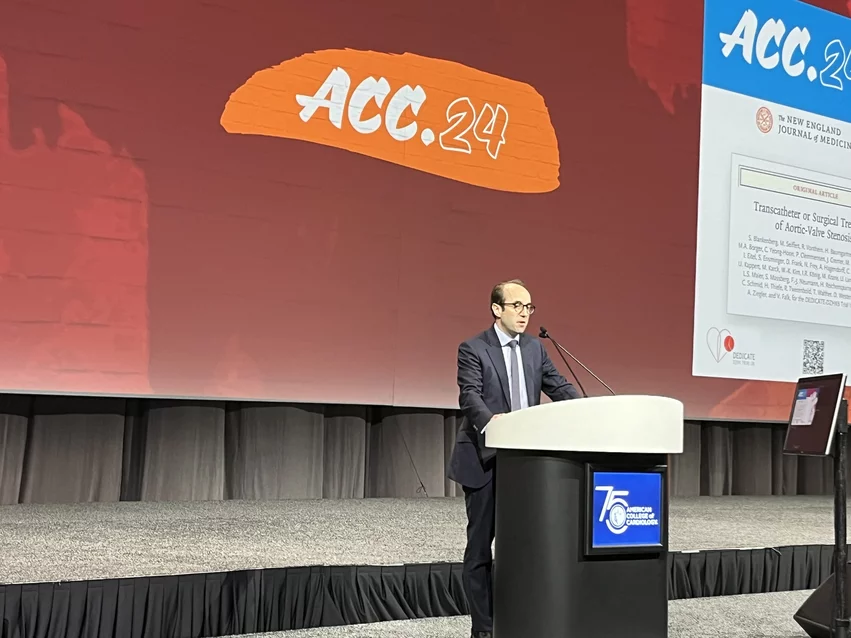ACC.24: TAVR linked to lower 1-year mortality, stroke rates than SAVR in low-risk patients
Transcatheter aortic valve replacement (TAVR) is noninferior to surgical aortic valve replacement (SAVR) when treating low-risk patients, according to late-breaking data presented at ACC.24, the annual meeting of the American College of Cardiology.
The team’s analysis was also published in full in the New England Journal of Medicine.[1]
The DEDICATE trial included data from more than 1,400 low-risk patients who underwent treatment in Germany from May 2017 to September 2022. All patients were eligible for either TAVR or SAVR and underwent randomization, though heart teams did still review each case and confirm the selected treatment choice was a good fit. The mean age was 74 years old, 57% were men and patients were excluded if they presented with a history of heart surgery or any additional coronary or valvular diseases requiring treatment.
Overall, the primary outcome—a composite of all-cause mortality and nonfatal stroke after one year—was seen in 5.4% of TAVR patients and 10% of SAVR patients. Diving deeper into the data, TAVR was associated with lower rates of all-cause death (2.6% vs. 6.2%), stroke (2.9% vs. 4.7%), stroke/transient ischemic attack (4.1% vs. 5.1%), disabling stroke (1.3% vs. 3.1%), all-cause mortality/disabling stroke (3.8% vs. 8.4%) and cardiovascular death (2% vs. 4.4%).
New-onset atrial fibrillation was seen in 12.4% of TAVR patients and 30.8% of SAVR patients. Meanwhile, TAVR was associated with slightly higher rate of prosthetic-valve dysfunction (1.6% vs. 0.6%) compared to SAVR.
“Although we primarily tested for noninferiority, the magnitude of the difference surprised us,” co-author Moritz Seiffert, MD, a cardiologist with BG University Hospital Bergmannsheil Bochum in Germany, explained. “Valve prosthesis selection based on individual patients’ anatomical and medical considerations may have played a role. In addition, the COVID-19 pandemic might have amplified the surgical risk.”
Seiffert et al. chose not to focus on one specific TAVR valve or protocol, instead letting heart teams provide care as they normally would.
“It’s completely industry independent, not focused on one particular device but comparing a catheter-based strategy to a surgical strategy overall,” Seiffert said. “That makes it more applicable and aligned with the types of decisions physicians are making in their daily medical work.”
An outside cardiologist’s perspective on TAVR vs. SAVR among low-risk patients
Pinak B. Shah, MD, director of the cardiac cath lab and section chief of interventional cardiology at Brigham and Women’s Hospital, wrote a separate editorial about the DEDICATE data, also published in the New England Journal of Medicine.[2]
“Given the more rapid return to normal activity associated with TAVR, these results are a win for TAVR among patients at low surgical risk, even according to the noninferiority trial design,” Shah wrote.
He also noted that this trial was not funded in any way by industry vendors, “thereby eliminating any perception of bias,” and emphasized that 43% of patients were women, a much higher number than seen in many other recent TAVR studies.
Shah did remind readers that there is still a lot to learn about the long-term outcomes of TAVR. Also, he said, “not all patients who are classified as being at low surgical risk are the same.” Still, this analysis helped highlight why TAVR continues to gain so much momentum throughout the world.
“With each passing year, the unknowns are becoming knowns, and the future of TAVR appears to be bright,” he concluded.


